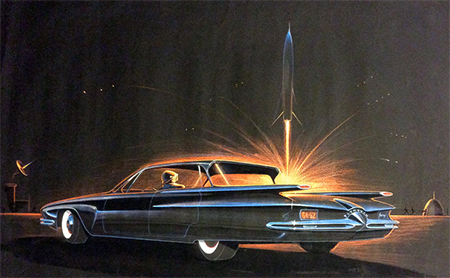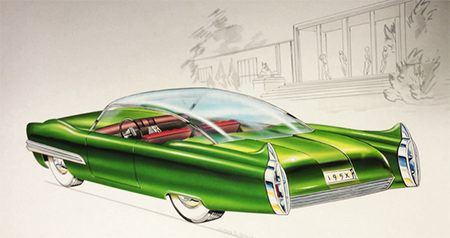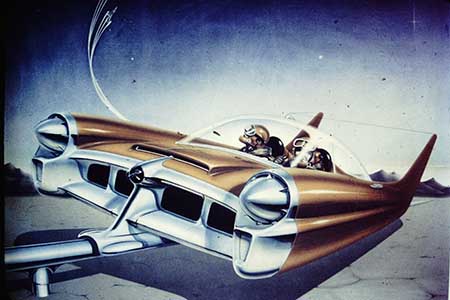
( A Plymouth Fury (1958) proposed for the 1962 model year by George Krispinsky, a Space Age-inspired Chrysler designer who Dad mentioned knowing. New York Times image from he collection of Robert Edwards).
I was a little freaked out when I wandered down to the lobby to get my daily hug from Rhonda, the den mother of the concierge crew at the front desk. The hug doesn’t freak me out- it is an element of human contact that both of us really enjoy. What got me agitated was what happened when the embrace was done I walked from the desk over to the row of mailboxes, inserted the little brass key in the lock and popped the little square brass door.
I saw the usual welter of junk- political solicitations from the mailing lists I was placed on in the mistaken belief that participating in the electoral process would do any good against the manifest corruption of our public life. Ads for hardware I no longer can justify, a reminder that my magazine subscriptions are expiring as I commence the Farewell to Arlington Summer Festival. I transferred all of it to the counter adjacent to the two rectangular batteries of boxes for sorting and deposit in the trash can in front of the mailboxes, which is why it is there.
It is a great system. The mail person puts the stuff in our boxes, we take out the junk and then discard it. The US Mail has become one of those self-licking ice cream cones, serving no particular purpose but the existence of the system, just like a lot of the rest of the bloated bureaucracy. But my eyes widened when I saw that the stack contained an actual letter, address hand-written in spidery ink.
The return address sticker indicated the letter was from my cousin Jan, who is, with the death of my folks, the Dean and senior member of the Socotra Clan.
I strolled back to the unit with the only two items worth keeping- the new week’s copy of the New Yorker and Jan’s letter. It was the first thing I examined when I got back to my work table in the dining room in front of the big winter that looks down on the garage exit and the charismatic church across the street.
Getting a real letter is an unusual enough event that I got a knife to slit open the envelope neatly. Inside was a folded piece of newspaper and a handwritten note on one page, slightly shaky cursive script. I am not sure I can still write in cursive- it has been a long time, and I live mostly on the internet- and I normally have to practice for a while first if there are forms I have to fill out. I normally use the block letters the Navy preferred, since the cursive muscle memory is nearly gone.
I put the letter aside and unfolded the news print. I looked at this stunning image of famed painter Frida
Frida Kahlo, and initially thought that was the subject of the note, since a pal in Detroit and I have been going back and forth about Frida’s time in the Motor City and her relationship with husband and socialist-realist muralist Diego Rivera. There is a retrospective on display at the DIA- no, not the one where I used to work, or the airport in Denver, but the Detroit Institute of Art:

(Frida Kahlo: Self Portrait with Monkeys, 1940)
I have no idea why Jan was interested in Frida, and turned the clipping over to realize that she may (and in fact is) interested in the magical realism of Frida’s work, but actually more stimulated by the article on the other side.

(This concept car is contemporaneous with Dad’s work. I probably need to drag my sorry butt up to Motown to see it: renderings from more than 100 car stylists will be on display at “American Dreaming: Detroit’s Golden Age of Automotive Design 1946 – 1973,” an exhibition opening on Thursday at Lawrence Technological University in Southfield, MI. I used to peddle college textbooks there to the future engineers and designers before joining the Navy. This car is from a concept rendering of the XL500 show car by Charles Balogh for Ford’s Lincoln Division. In the background is the black and white image of the Cranbrook Art Museum in nearby Bloomfield Hills, designed by Eliel Saarinen who also did the soaring terminal at Dulles International Airport. From the collection of Charles Balogh, who apparently was able to smuggle out his original works). Read the article here.
The article was from the New York Times issue of March 19th by Greg Beato, and titled: “The Creative Engines of Space-Age Car Culture.” There was this cool image of a concept car from the way-back machine in which lies the memory of my Dad and his early career work. Space age, man. Rockets to the moon! Cars styled like jets!
I went back to Jan’s letter to see what she said about the clipping.
“Dear Vic, this article made me wonder where your Dads originals of the “future” series of car designs he did for George Romney?” Then she gave me an update on what the main body of the Clan was up to- just like letters used to be.
I wrote her back electronically, since I don’t trust my handwriting anymore.
“Jan, I have always wondered about Dad ‘s body of work from the auto days of the 1950s . We certainly had many of his designs, some of them framed, but they were all photographs, not originals. I never asked him about them- I assumed they would turn up when we cleared out the house in Petoskey, but there was plenty of junk in his office but no original renderings.
Author Greg Beato may have told us why in this key paragraph:
“Because aesthetics were considered the key to sales, these studios were insular realms. Doors were kept locked, and artwork was not allowed to leave the building. When a project was finished, or a design was no longer considered potentially useful, the sketches were destroyed. While the car manufacturers retained some drawings, most of what survives today was smuggled out of the studios by the stylists themselves. Mr. Edwards estimates that around 10,000 sketches still exist from professional stylists working in the golden age.”
I suspect the originals (ironic in that his first major appliance launch after leaving the auto styling department was for the Kelvinator Originals line of refrigerators) remained property of AMC and may have been destroyed or remained property of Chrysler when it acquired the company, and now Fiat-Chrysler.
Too bad- I suspect they were worth something in the original rendering version, and shortly after his death, I had people sniffing around for original work that may have known the real value of them.”
I sighed as I mashed the “xmit” button, wishing I had written an original letter in fine copy-book hand. If I had a complete catalog of Dad’s original works, it might have really helped retirement. Oh well. I wonder where they are? I wonder if any of them are going to be at the exhibition?
Anyway, since the article talked about Space Age design- this is my favorite one of Dad’s:

(This will be the theme design for the Bill Socotra Rally of the Hoosier AMC Club, held on his birthday in Peru, Indiana, 08 August 2015. It is a Rambler, of course. Image Socotra).
Copyright 2015 Vic Socotra
www.vicsocotra.com
Twitter: @jayare303
